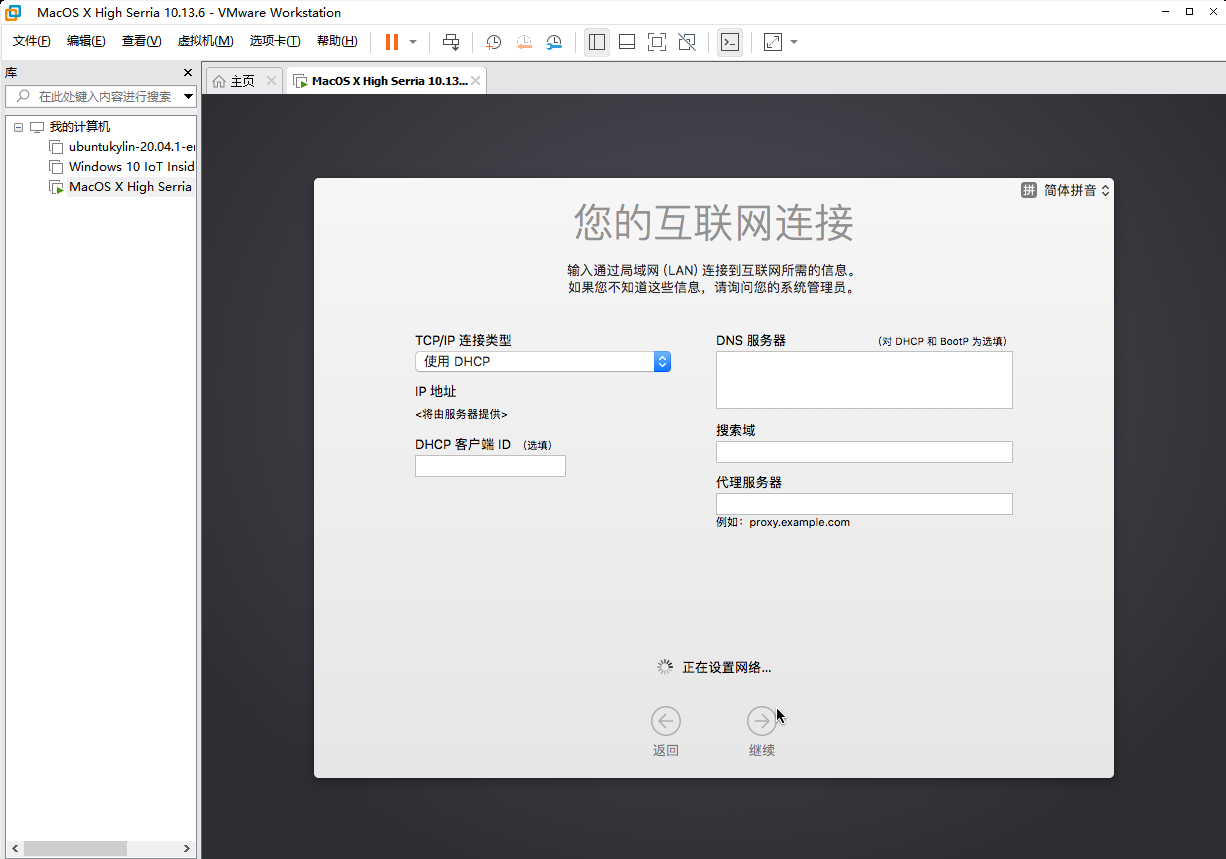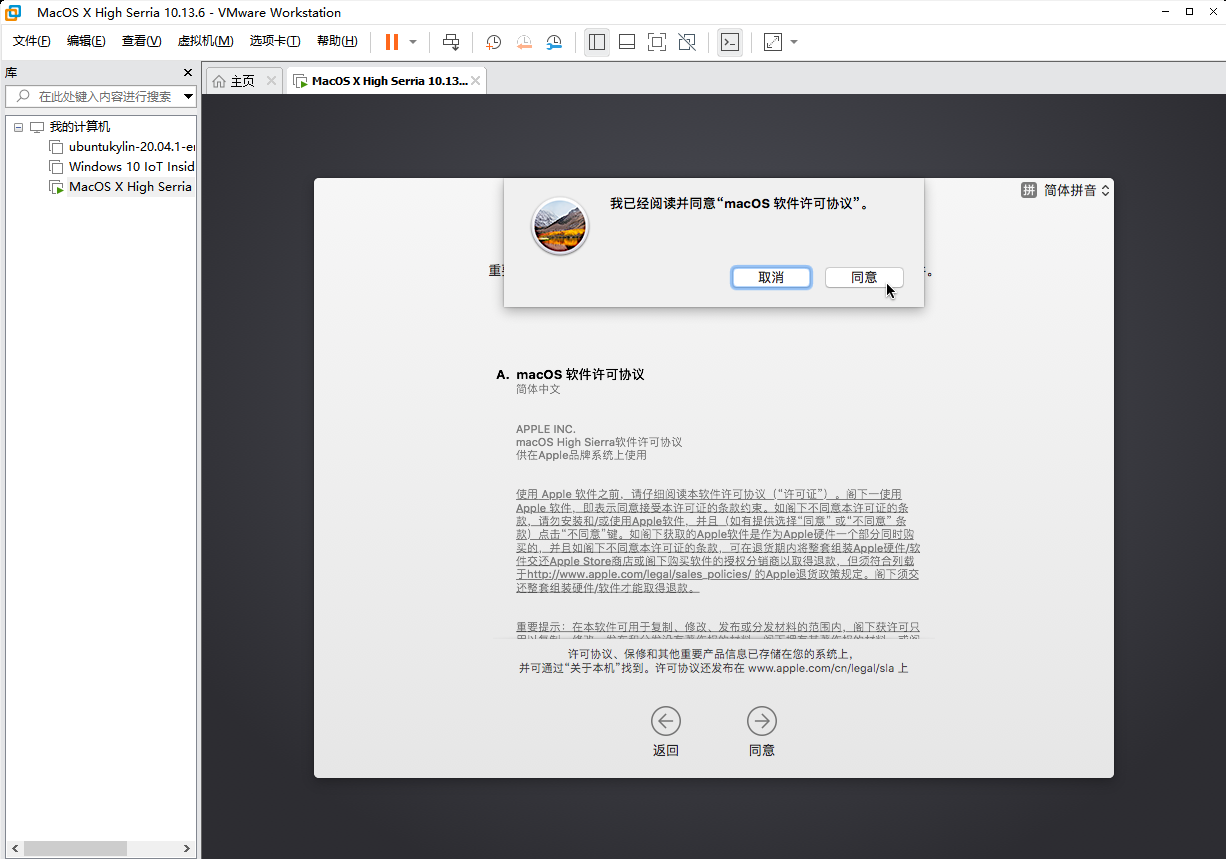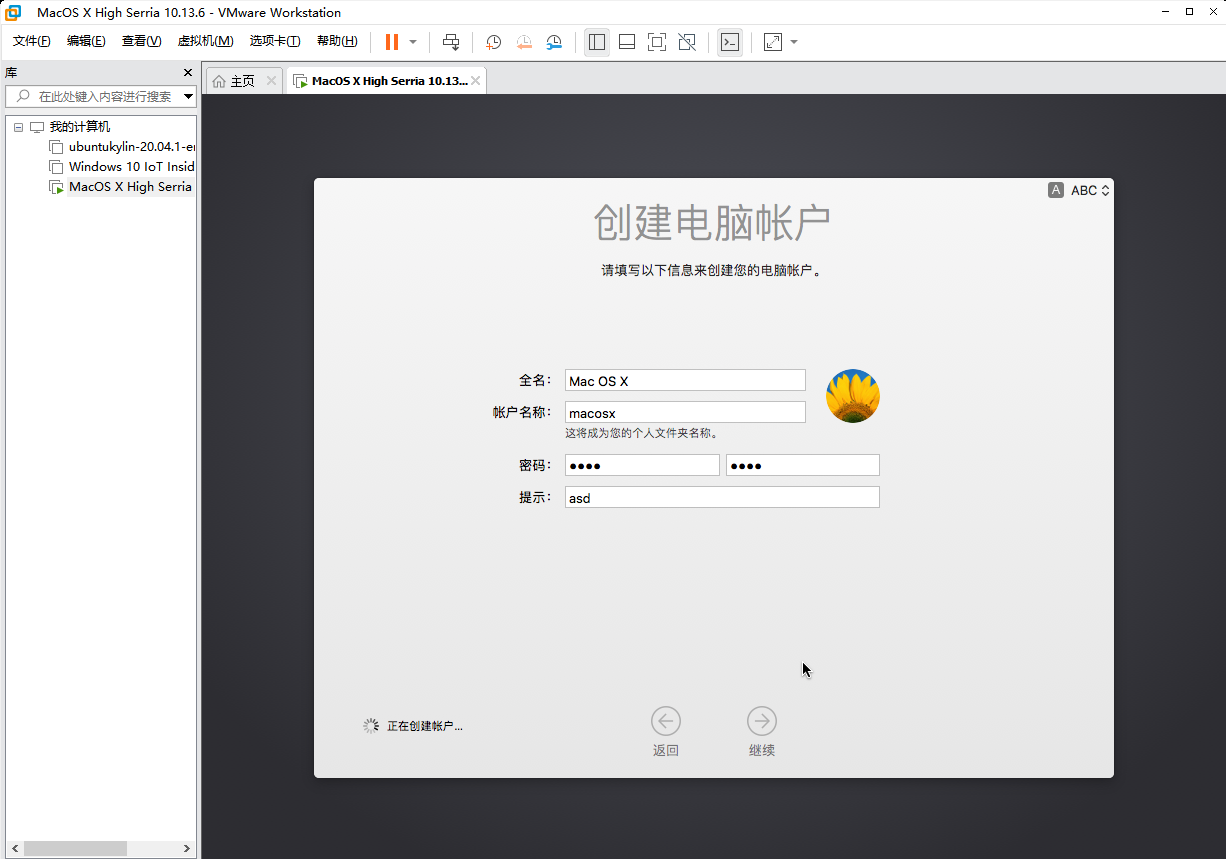安装macosx10.13high serria
- 2021 年 1 月 21 日
- 筆記
- 本教程所需资源下载链接:
链接://pan.baidu.com/s/1wGTezXz6zGvtlwpv6mMoSg
提取码:r6n9 - 安装VMware workstation 16.0,安装unlocker200,以管理员身份运行install.cmd。
-
安装VMware Workstation Pro 15(只有15的截图了抱歉)
下载后双击安装文件VMware-workstation-full-15.0.2-10952284
VMware安装界面
许可协议
这里需要讲一下增强型键盘驱动程序:
增强型虚拟键盘功能可更好地处理国际键盘和带有额外按键的键盘。此功能只能在 Windows 主机系统中使用。
由于增强型虚拟键盘功能可尽可能快地处理原始键盘输入,所以能够绕过 Windows 按键处理和任何尚未出现在较低层的恶意软件,从而提高安全性。使用增强型虚拟键盘功能时,如果按下 Ctrl+Alt+Delete,只有客户机操作系统会做出反应。
注:无法为共享或远程虚拟机配置增强型虚拟键盘设置。
个人觉得意义不大,而且安装需要重新引导,就不安装了。(如果安装可能使macos虚拟机键盘设定失效)
安装路径
产品更新
快捷方式
开始安装
安装结束
安装完毕,完成退出。
-
- 新建一个VMware虚拟机,选择稍后安装操作系统,操作系统选择Windows10 x64,命名为Mac OS X High Serria 10.13.6(由于测试原因导致虚拟机名字不一样,勿怪),保存。

- 加载macos镜像,修改Mac OS X High Serria 10.13.6.vmx:示例如下:
.encoding = “GBK”
config.version = “8”
virtualHW.version = “18”
mks.enable3d = “TRUE”
pciBridge0.present = “TRUE”
pciBridge4.present = “TRUE”
pciBridge4.virtualDev = “pcieRootPort”
pciBridge4.functions = “8”
pciBridge5.present = “TRUE”
pciBridge5.virtualDev = “pcieRootPort”
pciBridge5.functions = “8”
pciBridge6.present = “TRUE”
pciBridge6.virtualDev = “pcieRootPort”
pciBridge6.functions = “8”
pciBridge7.present = “TRUE”
pciBridge7.virtualDev = “pcieRootPort”
pciBridge7.functions = “8”
vmci0.present = “TRUE”
hpet0.present = “TRUE”
nvram = “MacOS X High Serria 10.13.6.nvram”
virtualHW.productCompatibility = “hosted”
powerType.powerOff = “soft”
powerType.powerOn = “soft”
powerType.suspend = “soft”
powerType.reset = “soft”
displayName = “MacOS X High Serria 10.13.6”
usb.vbluetooth.startConnected = “TRUE”
smc.present = “TRUE”
smc.version = “0”
firmware = “efi”
sensor.location = “pass-through”
guestOS = “darwin17-64”
tools.syncTime = “FALSE”
sound.autoDetect = “TRUE”
sound.virtualDev = “hdaudio”
sound.fileName = “-1”
sound.present = “TRUE”
numvcpus = “2”
cpuid.coresPerSocket = “2”
memsize = “2048”
mem.hotadd = “TRUE”
sata0.present = “TRUE”
nvme0.present = “TRUE”
nvme0:0.fileName = “MacOS X High Serria 10.13.6.vmdk”
sata0:1.deviceType = “cdrom-raw”
sata0:1.fileName = “auto detect”
sata0:1.present = “TRUE”
usb.present = “TRUE”
ehci.present = “TRUE”
usb_xhci.present = “TRUE”
svga.graphicsMemoryKB = “8388608”
ethernet0.addressType = “generated”
ethernet0.virtualDev = “e1000e”
serial0.fileType = “thinprint”
serial0.fileName = “thinprint”
ethernet0.present = “TRUE”
serial0.present = “TRUE”
extendedConfigFile = “MacOS X High Serria 10.13.6.vmxf”
floppy0.present = “FALSE”
sata0:0.fileName = “MacOS X High Serria 10.13.6.vmdk”
sata0:0.present = “TRUE”
numa.autosize.cookie = “20022”
numa.autosize.vcpu.maxPerVirtualNode = “2”
uuid.bios = “56 4d 2e e8 d5 31 25 2e-39 4b da a6 3b 85 8c 3e”
uuid.location = “56 4d 2e e8 d5 31 25 2e-39 4b da a6 3b 85 8c 3e”
sata0:0.redo = “”
pciBridge0.pciSlotNumber = “17”
pciBridge4.pciSlotNumber = “21”
pciBridge5.pciSlotNumber = “22”
pciBridge6.pciSlotNumber = “23”
pciBridge7.pciSlotNumber = “24”
usb.pciSlotNumber = “32”
ethernet0.pciSlotNumber = “160”
sound.pciSlotNumber = “33”
ehci.pciSlotNumber = “34”
usb_xhci.pciSlotNumber = “192”
vmci0.pciSlotNumber = “35”
sata0.pciSlotNumber = “36”
nvme0.pciSlotNumber = “224”
svga.vramSize = “268435456”
vmotion.checkpointFBSize = “134217728”
vmotion.checkpointSVGAPrimarySize = “268435456”
vmotion.svga.mobMaxSize = “1073741824”
vmotion.svga.graphicsMemoryKB = “8388608”
vmotion.svga.supports3D = “1”
vmotion.svga.baseCapsLevel = “9”
vmotion.svga.maxPointSize = “1”
vmotion.svga.maxTextureSize = “16384”
vmotion.svga.maxVolumeExtent = “2048”
vmotion.svga.maxTextureAnisotropy = “16”
vmotion.svga.lineStipple = “0”
vmotion.svga.dxMaxConstantBuffers = “14”
vmotion.svga.dxProvokingVertex = “0”
vmotion.svga.sm41 = “1”
vmotion.svga.multisample2x = “1”
vmotion.svga.multisample4x = “1”
vmotion.svga.msFullQuality = “1”
vmotion.svga.logicOps = “1”
vmotion.svga.bc67 = “9”
vmotion.svga.sm5 = “1”
vmotion.svga.multisample8x = “1”
vmotion.svga.logicBlendOps = “1”
ethernet0.generatedAddress = “00:0C:29:85:8C:3E”
ethernet0.generatedAddressOffset = “0”
vmci0.id = “998607934”
monitor.phys_bits_used = “45”
cleanShutdown = “TRUE”
softPowerOff = “TRUE”
usb_xhci:4.present = “TRUE”
usb_xhci:4.deviceType = “hid”
usb_xhci:4.port = “4”
usb_xhci:4.parent = “-1”
usb_xhci:6.speed = “2”
usb_xhci:6.present = “TRUE”
usb_xhci:6.deviceType = “hub”
usb_xhci:6.port = “6”
usb_xhci:6.parent = “-1”
usb_xhci:7.speed = “4”
usb_xhci:7.present = “TRUE”
usb_xhci:7.deviceType = “hub”
usb_xhci:7.port = “7”
usb_xhci:7.parent = “-1”
usb:1.speed = “2”
usb:1.present = “TRUE”
usb:1.deviceType = “hub”
usb:1.port = “1”
usb:1.parent = “-1”
toolsInstallManager.updateCounter = “5”
toolsInstallManager.lastInstallError = “21004”
sata0:1.startConnected = “FALSE”
ethernet0.displayName = “VMnet8 (NAT”
ethernet0.linkStatePropagation.enable = “TRUE”
sata0:1.autodetect = “TRUE” - 注意!尽量不要更改我上述的代码,如果读者对此颇有建树那么可以更改
- 关闭界面,进行unlocker破解。
- 将从我分享的资源里的Darwin.iso复制到C:\Program Files (x86)\VMware\VMware Workstation下
- 将虚拟机启动。下面放图:





- 完成










